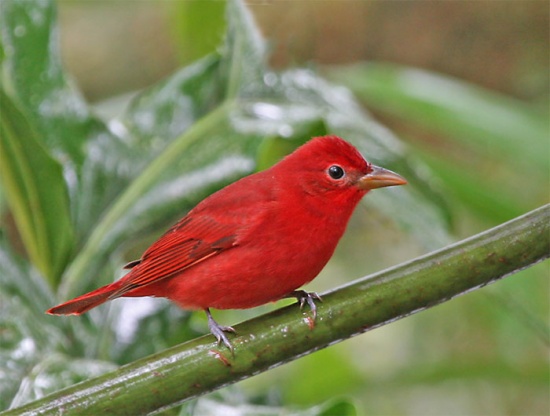(add photo of female) |
|||
| Line 12: | Line 12: | ||
*''P. r. cooperi'' - breeds southwest US and northern Mexico. Winters to southern Baja and southern Mexico. | *''P. r. cooperi'' - breeds southwest US and northern Mexico. Winters to southern Baja and southern Mexico. | ||
*''P. r. rubra'' - breeds southeast US. Winters to Amazonian Brazil and n. Bolivia. | *''P. r. rubra'' - breeds southeast US. Winters to Amazonian Brazil and n. Bolivia. | ||
| − | [[Image:d08_2329.jpg|thumb|450px|right|'''Female'''. Photo by {{user|Gary+Clark|Gary Clark}} <br/>Location: Parque Metropolitano, Panama City, [[Panama]].]] | + | [[Image:d08_2329.jpg|thumb|450px|right|'''Female'''. Photo by {{user|Gary+Clark|Gary Clark}} <br/>Location: Parque Natural Metropolitano, Panama City, [[Panama]].]] |
==Habitat== | ==Habitat== | ||
Revision as of 17:42, 17 January 2010
- Piranga rubra
Identification
7-8" (18-20 cm). Male solid rose-red with pale bill. Female pale olive green above, dull yellow below.
Distribution
Southern United States and northern Mexico.
Taxonomy
It was placed in the Thraupidae, but is more likely a relative of the cardinals. Consists of two subspecies.
Subspecies1
- P. r. cooperi - breeds southwest US and northern Mexico. Winters to southern Baja and southern Mexico.
- P. r. rubra - breeds southeast US. Winters to Amazonian Brazil and n. Bolivia.
Habitat
Open woodland along streams.
Behaviour
It catches bees in flight, killing them by beating against a branch; the stinger is removed by rubbing it on a branch. It then eats the bee. It also eats wasp larvae. It first catches the adult insects and then perches near the nest to tear it open and get the grubs.
It builds an open cup nest of dried grasses and other vegetation. 3-4 pale blue to pale green, marked with dark spots and blotches, eggs are laid.
References
- Clements, James F. 2007. The Clements Checklist of Birds of the World. 6th ed., with updates to October 2007. Ithaca: Cornell University Press. ISBN 9780801445019





